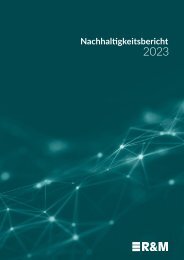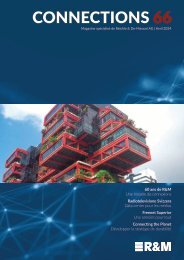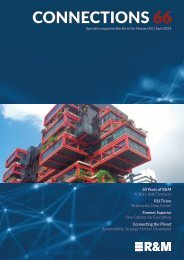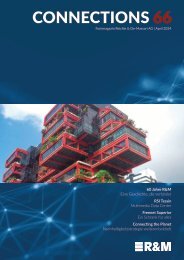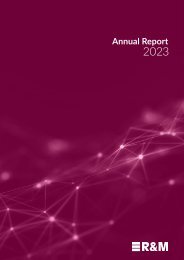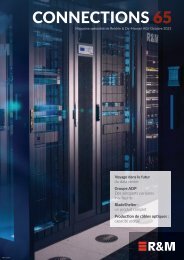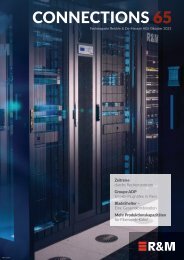CONNECTIONS_65-e
Specialist magazine CONNECTIONS no. 65
Specialist magazine CONNECTIONS no. 65
You also want an ePaper? Increase the reach of your titles
YUMPU automatically turns print PDFs into web optimized ePapers that Google loves.
Forecasts about the development of the Data Center market<br />
the issues of carbon footprint, decarbonization<br />
and power supply. These questions<br />
have to be asked at all levels, from premises<br />
and buildings to computer rooms and even<br />
high-performance chips. In particular, data<br />
center operators will be faced with new underlying<br />
conditions in the form of extended<br />
state norms and adapted industry standards<br />
for data centers, the call for the recycling of<br />
used raw materials, waste heat utilization<br />
concepts for the surrounding buildings and<br />
residents, and also increasingly the use of<br />
renewable energy sources.<br />
Spontaneous, fast, complex<br />
Data center customers are having to act faster<br />
and faster. Business models are adapted<br />
or scaled. Digitalization gives companies the<br />
opportunity to implement many things in a<br />
short space of time. For security or competitive<br />
reasons, they often release services, apps<br />
and updates at short notice. Applications for<br />
masses of end users, or complex applications<br />
with a high workload for the servers are on<br />
the agenda.<br />
Data centers must therefore be responsive.<br />
And they have to be able to provide scalable<br />
infrastructures tailored to the customer<br />
and project at short notice. Together with<br />
customers, operators are making complex<br />
decisions more often than ever before.<br />
Understanding new customer applications<br />
leads to an adapted conversion into new IT<br />
equipment (such as servers and storage) and<br />
its networking with corresponding switches.<br />
If this equipment is to be integrated into an<br />
efficient environment and perhaps even into<br />
a partially existing infrastructure, there is more<br />
to be done than just filling up free spaces in<br />
existing IT cabinets. The increasing demand<br />
for efficiency in the data center requires the<br />
coordination of all sections of the infrastructure<br />
in order to optimize the critical interaction<br />
between compute and non-compute layers.<br />
Would anyone have thought of this recently<br />
with conventional planning focused on individual<br />
sections? All plans have to be adjusted<br />
to one another, and stand-alone solutions will<br />
no longer meet the targets set in the future.<br />
What that means for cooling<br />
The challenges associated with cooling are<br />
impressive. When the computer room was<br />
first set up, all the amenities were perfectly<br />
adjusted to each other: Cold aisles and hot<br />
50 %<br />
increase in the electrical footprint<br />
of all data centers by 2025<br />
500 %<br />
growth of globally generated<br />
data by 2025<br />
Source: Schneider Electric<br />
aisles, air flow, fans and cooling systems,<br />
operating temperature of IT equipment, etc.<br />
Servers with larger computing capacity are<br />
now entering the computer room because<br />
customers want to launch new, powerful digital<br />
products. Suddenly something changes<br />
as regards cooling. Fans are operating at full<br />
speed on a permanent basis and consuming<br />
more power. The cause has to be investigated,<br />
and that no doubt means maintenance work,<br />
in the worst case operational interruptions<br />
and subsequent renovation work. Cable<br />
bundles have to be laid differently so that<br />
the air can flow optimally again.<br />
If installations are equipped at maximum<br />
capacity at the beginning of expansion, this<br />
can lead to inefficiencies and even damage<br />
to the system. Here, a simple example: A rack<br />
was initially equipped with two blades, which<br />
together had an output of 2 kW. But the cooling<br />
system has already been configured for 20<br />
kW or for fully equipped rack rows. Excessive<br />
cooling changes the dew point. Moisture<br />
accumulates. Certain systems stop when<br />
there is too much cold or the cooling system<br />
runs at a level that is too low, resulting in a<br />
constant switching on and off. This can lead to<br />
complete cooling system failure prematurely.<br />
Some data centers take precautions by<br />
proactively planning in headroom. In doing<br />
so, they have to remember that cooling and<br />
power supply must be adjusted to both the<br />
reduced and the full IT load.<br />
One possible solution for this would be<br />
decentralized, modular inline and side cooling<br />
units such as the BladeCooling units from<br />
R&M Tecnosteel. They can be dimensioned<br />
according to the respective computing<br />
performance.<br />
24 %<br />
of Executives report that over 50 %<br />
of their data centers will configure<br />
themselves by 2025<br />
75 %<br />
of data will be processed in<br />
edge data centers<br />
Here, too, an interdependency would have<br />
to be considered: The energy and space<br />
requirements of the inline and side cooling<br />
units must be taken into account when planning<br />
the expansion. Once again, IT equipment<br />
and operating temperatures, ventilators,<br />
cooling system, containment and air routing<br />
have to be coordinated with one another.<br />
Blade cooling for heat loads from 4 to 42 kW<br />
In-row cooling<br />
030.7913<br />
050.7363<br />
030.7914<br />
10|2023–<strong>65</strong> <strong>CONNECTIONS</strong> | 5









